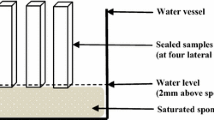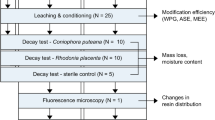Abstract
Wood modification is commonly used to alter and improve wood properties. This study investigates the effects of impregnation modification with four environmentally nontoxic agents on the UV-resistance and water absorption properties of solid wood. Scots pine (Pinus sylvestris) was impregnated with modifiers by pressure device. The solid wood specimens were treated with water glass, silicone, melamine, and tall oil. The modified samples were analyzed by SEM microscopy, and thickness swelling, water absorption and UV resistance were determined. The penetration of the studied modifiers differed. The melamine-treated samples were found to exhibit the best impregnation, which also affected the wood properties favorably. The melamine-treated solid pine wood samples absorbed half of the water absorbed by wood treated with the other solutions and attained the best results in thickness swelling and weathering tests. It is concluded that impregnation modification of Scots pine is dependent on the nature of the modifier and based on the results of this study, melamine solution treatment is found to have a positive effect on the properties of solid pine wood.






Similar content being viewed by others
References
Archer K, Lebow S (2006) Wood preservation. In: Walker JCF (ed) Primary wood processing, 2nd edn. Springer, pp 297–338
Butylina S, Martikka O, Kärki T (2011) Properties of wood polypropylene composites: effect of wood fibre source. Appl Compos Mater 18:101–111
Chen GC (2009) Treatment of wood with polysilicic acid derived from sodium silicate for fungal decay protection. Wood Fiber Sci 41:220–228
De Vetter L, Despraetere G, Janssen C, Stevens M, Van Ackker J (2009) Potential contribution of organosilicon compounds to reduced leaching of biocides in wood protection. Ann For Sci 66:209. doi:10.1051/forest/2008091
Deka M, Saikia CN (2000) Chemical modification of wood with thermosetting resin: effect on dimensional stability and strength property. Bioresour Technol 73:179–181
Egerton RF (2005) Physical principles of electron microscopy: an introduction to TEM, SEM and AEM. Springer, New York
Evans PD (2013) Weathering of wood and wood composites. In: Rowell RM (ed) Handbook of wood chemistry and wood composites, 2nd edn. Taylor & Francis Group, Boca Raton, pp 151–216
Ghosh SC, Militz H, Mai C (2009a) Natural weathering of Scots pine (Pinus sylvestris L.) wood modified by functionalized commercial silicone emulsions. In: Englund F, Hill CAS, Militz H, Segerholm BK (eds) The fourth European conference on wood modification. pp 253–260
Ghosh SC, Militz H, Mai C (2009b) The efficacy of commercial silicones against blue stain and mould fungi in wood. Eur J Wood Prod 67:159–167
Gindl W, Zargar-Yaghubi F, Wimmer R (2003) Impregnation of softwood cell walls with melamine-formaldehyde resin. Bioresource Technol 87:325–330
Hansmann C, Deka M, Wimmer R, Gindl W (2006) Artificial weathering of wood surfaces modified by melamine formaldehyde resins. Holz Roh Werkst 64:198–203
Hill CAS (2006) Wood modification: chemical, thermal, and other processes. John Wiley & Sons Ltd, Hoboken
Hyvönen A, Nelo M, Piltonen P, Niinimäki J (2006) Using the emulsion technique and an iron catalyst to enhance the wood protection properties of tall oil. Holz Roh Werkst 65:247–249
Kärkkäinen M (2007) Structure and properties of wood. Metsäkustannus Oy, (In Finnish)
Kataoka Y, Kiguchi M, Fujiwara T, Evans PD (2005) The effects of within-species and between-species variation in wood density on the photodegradation depth profiles of sugi (Cryptomeria japonica) and hinoki (Chamaecyparis obtuse). J Wood Sci 51:531–536
Koski A (2008) Applicability of crude tall oil for wood protection. Dissertation. University of Oulu
Larnøy E, Militz H, Eikenes M (2005) Uptake of chitosan based impregnation solutions with varying viscosities in four different European wood species. Holz Roh Werkst 63:456–462
Lukowsky D (2002) Influence of the formaldehyde content of water based melamine formaldehyde resins on physical properties of Scots pine impregnated therewith. Holz Roh Werkst 60:349–355
Mai C, Militz H (2004a) Modification of wood with silicon compounds. Treatment systems based on organic silicon compounds—a review. Wood Sci Technol 37:453–461
Mai C, Militz H (2004b) Modification of wood with silicon compounds. Inorganic silicon compounds and sol–gel systems: a review. Wood Sci Technol 37:339–348
Matsumura J, Booker RE, Ridoutt BG, Donaldson LA, Matsunaga H, Oda K (1999) Impregnation of radiata pine wood by vacuum treatment II: effect of pre-steaming on wood structure and resin content. J Wood Sci 45:456–462
Militz H (2008) Process and properties of thermally modified wood manufactured in Europe. In: Schultz TP, Militz H, Freeman MH, Goodell B, Nicholas DD (eds) Development of commercial wood preservatives. American Chemical Society, Washington DC, pp 372–388
Minolta Konica (1998) Precise color communication, color control from perception to instrumentation. Konica Minolta Sensing, New York
Müller U, Steiner M (2010) Colour stabilization of wood composites using polyethylene glycol and melamine resin. Eur J Wood Prod 68:435–443
Olsson T, Megnis M, Varna J, Lindberg H (2001) Study of the transverse liquid flow paths in pine and spruce using scanning electron microscopy. J Wood Sci 47:282–288
Owen MJ (2007) Say yes to silicones! In: Clarson SJ, Fitzgerald JJ, Owen MJ, Smith SD, Van Dyke ME (eds) Science and technology of silicones and silicone-modified materials. American Chemical Society, Washington DC, pp 2–8
Pfeffer A, Dieste A, Mai C, Militz H (2010) Effects of water glass and DMDHEU treatment on the colonization of wood by Aureobasidium pullulans. Eur J Wood Prod 69:303–309
Rowell RM (2006) Chemical modification of wood: a short review. Wood Mater Sci Eng 4:29–33
Saranpää P (2002) Properties of wood [Puun ominaisuudet]. In: Hyvämäki T (ed) Tapion Taskukirja, 24th edn. Kustannusosakeyhtiö Metsälehti, Helsinki, pp 514–523 (In Finnish)
Scholz G, Krause A, Militz H (2010) Exploratory study on the impregnation of Scots pine sapwood (Pinus sylvestris L.) and European beech (Fagus sylvatica L.) with different hot melting waxes. Wood Sci Technol 44:379–388
SFS-EN ISO 4892-2 (2006) Plastics. Method of exposure to laboratory light sources. Part 2: xenon-arc lamps. Finnish Standards Association, Helsinki
Shukla SR, Kamdem DP (2010) Swelling of polyvinyl alcohol, melamine and urethane treated southern pine wood. Eur J Wood Prod 68:161–165
Singh T, Singh AP (2012) A review on natural products as wood protectant. Wood Sci Technol 46:851–870
Temiz A, Terziev N, Jacobsen B, Eikenes M (2006) Weathering, water absorption, and durability of silicon, acetylated, and heat-treated wood. J Appl Polym Sci 102:4506–4513
Temiz A, Alfredsen G, Eikenes M, Terziev N (2008) Decay resistance of wood treated with boric acid and tall oil derivates. Bioresour Technol 99:2102–2106
Turkulin H, Sell J (2002) Investigations into the photodegradation of wood using micro tensile testing. Part 4. Tensile properties and fractography of weathered wood. Holz Roh Werkst 60:96–105
Walker J (2006) Basic wood chemistry and cell wall ultrastructure. In: Walker JCF (ed) Primary wood processing, 2nd edn. Springer, Dordrecht, pp 23–67
Wang JZ, DeGroot R (1996) Treatability and durability of heartwood. In: Ritter MA, Duwadi SR, Lee PDH (eds) National conference on wood transportation structures, US Department of Agriculture, Forest Service, Forest Products Laboratory, Madison WI, 23–25 October 1996
Author information
Authors and Affiliations
Corresponding author
Rights and permissions
About this article
Cite this article
Lahtela, V., Kärki, T. Improving the UV and water-resistance properties of Scots pine (Pinus sylvestris) with impregnation modifiers. Eur. J. Wood Prod. 72, 445–452 (2014). https://doi.org/10.1007/s00107-014-0804-x
Received:
Published:
Issue Date:
DOI: https://doi.org/10.1007/s00107-014-0804-x




